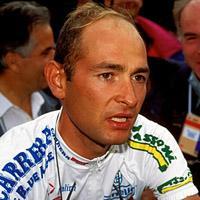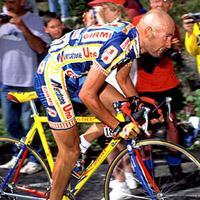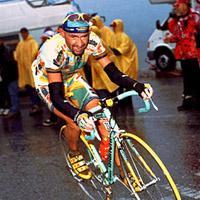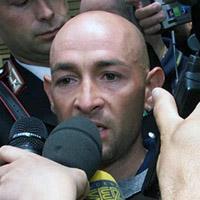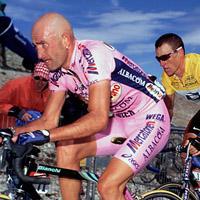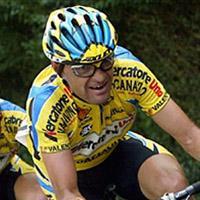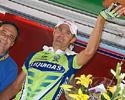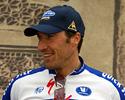
Recently on Cyclingnews.com |
Flashbacks from the peloton, May 25, 2009
The 1999 Giro - a Pantani retrospective
As the Giro d'Italia celebrates its centenary edition, events that took place during the race a decade ago formed one of the most tumultuous chapters in the event's history. Marco Pantani's ejection for a high haematocrit level would have greater ramifications for the Italian climbing legend and cycling in general. Cyclingnews' Les Clarke takes a look at why the wounds of that Giro are still raw despite the passing of 10 years.
In the hearts of many fans, Marco Pantani won the 1999 Giro d'Italia. That he didn't make it to Milan after being forced to exit the race by officials makes little difference to those who witnessed his feats that year. The most significant impact of events in June 1999 was Pantani's spiral into the depths of depression and the subsequent loss of an enigmatic champion.
'Il Pirata' had taken the Giro-Tour double the year before and was in ominous form heading into the '99 edition of Italy's Grand Tour. Looking good was Banesto's José Maria Jimenez and Kelme-Costa Blanca rider Roberto Heras, while Lampre rider Oscar Camenzind came into the event as a dark horse.
1994 Tour de France
|
1995 Tour de France: Alpe d'Huez
|
In a tragic sequence of events during the years that followed the 1999 Giro, Pantani and Jimenez met with early deaths, while Heras and Camenzind were both sanctioned for EPO use. Jimenez's teammate Alex Zülle had recently made a return to competition after admitting to EPO use at Festina; the atmosphere surrounding the peloton in relation to drug use was to take another turn for the worse.
Race leader Pantani was ejected when it appeared certain he would take a second consecutive crown in his home Grand Tour. With a haematocrit reading of 52 percent, the UCI was left with no choice but to expel him from the event much to the dismay of the Tifosi della il pirata, of which he had thousands.
It came on the morning of June 5, the day of the Giro's queen stage. The 21st day of racing included the Passo del Tonale (1883m), Passo di Gavia ( the Cima Coppi, at 2621m), Passo del Mortirolo (1852m) and Valico di Santa Cristina (1427m). Designed to showcase the attacking flair and climbing prowess of Pantani, his absence in such an epic stage left a bitter taste in the mouths of fans who had hoped to see their hero cement his place at the top of the standings ahead of the race's final stage to Milan. Pantani never wore the maglia rosa again.
1997 Tour de France: Alpe d'Huez
|
1998 Tour de France: Galibier
|
The previous two days had seen Pantani dominate the race, winning stage 19 to Alpe Di Pampeago, an amazing display of solo riding on the tough slopes of the dolomites. Gilberto Simoni was second that day, finishing 1:07 behind his countryman and indicating he had what it took to be the 'best of the rest' as it was that year. The following day Pantani was at it again, winning alone, with Simoni again finishing 1:07 in arrears.
Pantani never recovered from that setback and the episode instigated a steady spiral for the Italian. Despite winning that infamous stage of the 2000 Tour de France mano-a-mano up the slopes of Mont Ventoux against Lance Armstrong, Pantani suffered immensely from depression, with another expulsion in the 2003 Giro the final chapter ahead of his death in February 14, 2004.
1999 Giro d'Italia: Pantani ejected
|
2000 Tour de France: Ventoux
|
There's a direct link to that race in the form of Acqua & Sapone - Caffe Mokambo team captain in this year's Giro, Stefano Garzelli. Then aged 26, the rider from Varese was Pantani's teammate in the 1999 edition and was forced to abandon the race when the Mercatone Uno-Bianchi squad quit en masse following the announcement that its captain would be going home due to his irregular blood values. Then-UCI President Hein Verbruggen said at the time that the penalty was "for health reasons," but implied that Pantani's test was the product of EPO use.
There was the scent of the Festina scandal in the actions taken by those Mercatone Uno-Bianchi riders, and less than 12 months after the explosive events in France in July 1998 it was becoming obvious that some of the highest profile members of the peloton were still treading the thin line between success and seclusion from the sport. In the case of Pantani, it was the beginning of a long seclusion that ended with his death.
2000 Tour de France: Joux-Plane
|
2003 Giro d'Italia: Pantani's last race
|
While Ivan Gotti, who had struggled behind the maglia rosa on the slopes of Alpe Di Pampeago during stage 19 won the Giro's queen stage in the absence of Il Pirata, securing his victory in the general classification when the race finished in Milan the next day, it was a hollow victory for riders and fans alike. It's undeniable that many will also choose to remember, with greater fondness, Marco Pantani's amazing exploits during the 1999 Giro rather than the scourge of drug use, which will taint that edition forever.
A decade on, those who 'survived' the years after that Giro have seen the lessons learnt from the years when EPO use was being unearthed by the authorities and the media, as the culture of omerta started to fade slightly and a new era of transparency was advocated. It has been a tough 10 years and its testament to the longevity of the following seven riders that they are still competing in the season's second-biggest race.
2004: Funeral procession
|
The 'survivors' of the 1999 Giro
Six riders who competed in the 1999 Giro d'Italia started this year's edition in Venice. While most of the men they rode with and against in that tumultuous race 10 years ago have retired, this sextet still contains a couple of jokers in the pack who could upset their fancied rivals with strong performances.
Names such as Gilberto Simoni, Marzio Bruseghin and Stefano Garzelli were bandied about ahead of this year's edition of the race as men to look out for on the general classification. Some fans may not realise it but Simoni was a name on many lips when the race took place a decade ago.

